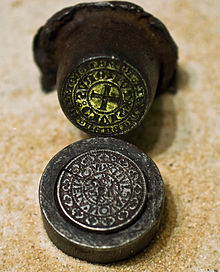Turnose



The Turnose , ( French: gros Tournois ) Turnos or Turnosgroschen was a coin of daily money transactions created by the Capetians in the Middle Ages .
Coin history
Louis IX From 1266 the saint had the “ grossus denarius Turonus ” (German: “thick denarius of Tours ”) minted for the equivalent of 12 black pfennigs ( deniers = 1 Sol = 1/20 livre of the currency of Tours). With the highest fineness to be represented at that time of 23/24 carats and a weight of around 4 grams, 58 pieces were once minted from the "rough" marrow of Tours (217.558 g). This had prevailed throughout France since around 1050 .
He enlarged the image of the “denier tournois” on the coin, adding a second outer inscription on the face: “ B (e) N (e) DICTV (m) SIT NOME (n) D (omi) NI N (east) RI DEI IH (e) SV XP (Christ) I ”(German:“ Praise be to the name of our Lord and God Jesus Christ ”). On the picture side a wreath of twelve lilies was added.
King Louis the Saint got to know the model of this silver groschen on his crusade in Acre in 1250 : The crusaders had minted golden "Sarzinas" there. These were in turn by Dinar coins of Fatimid - Dynasty inspired.
The Turnosgroschen - the German word Groschen derives from “ grossus denarius Turonus ” - was later coined by Ludwig's successors Philip IV and even by Charles V in the late 14th century using the same type in large quantities.
Due to the trade relations of the French, the Turnose caused numerous imitations along the Rhine in the German-speaking and Dutch regions. In the Kingdom of Naples he was imitated as Gigliato during the 14th century. Even the original coin was accepted as a universal means of payment as far as Brandenburg .
Elector Friedrich II. The Meek of Saxony had 20 pieces struck on the Rhenish guilders according to the coinage system from 1456/57 to 1461 with the Roman date 1457 in the Leipzig mint under mint master Hans Stockart with the mint master's mark Lilie Turnosegroschen as upper currency . They show an isosceles cross in the middle of a double circle, while on the opposite side the Thuringian stick can be seen above a helmet. The Saxon Turnosegroschen were the successors of the Judenkopfgroschen , which were also part of a double currency (Oberwähr) and therefore also created a great deal of confusion in trade and change in Saxony.
The Turnosegroschen was used in payment transactions well into the 16th century.
Turnospfennige, coinage since the 13th century with increasing copper content output, received for their darkening in Rhineland Latin nickname Mauri (from maurus "black"), who as carrots over went on a Rhine penny coin.
literature
- A. Blanchet, A. Dieudonné: Manuel de Numismatique francaise . 3 volumes. Paris 1912, 1916, 1930
- Arthur Suhle : Cultural History of Coins, Battenberg Verlag, Munich 1969, p. 117.
- J. Lafaurie: Les monnaies des rois de France. Hugues Capet à Louis XII. Paris / Basel 1951
- Dela von Boeselager : The treasure trove from the Boeselagerhof and its legendary tradition . In: The Turnosgroschen from the coin treasure of the Boeselagerhof Bonn (= Bonn numismatic studies ). Bonn 2015, ISBN 978-3-941612-08-2 , table of contents (PDF)
Web links
- Turnosenfund Erfurt. Database about the Turnosen finds from Erfurt
Individual evidence
- ^ Gerhard Krug: The Meissnisch Saxon Groschen 1338-1500 , Berlin 1974, p. 148
- ↑ klingenberg.info (PDF)
- ^ Henry Otto Schwabe: Germanic coin names. In: Modern Philology. Volume 13, 1915/1916, p. 603, Textarchiv - Internet Archive . - Wolfgang Hess: The Rhenish coinage in the 14th century and the emergence of the Kurheinische Münzverein. In: Hans Patze: The German territorial state in the 14th century. 2nd edition, Volume 1, 1986, p. 271. - Helmut Kahnt, Bernd Knorr: Old dimensions, coins and weights: a lexicon . Licensed edition of the Bibliographisches Institut, Leipzig. Bibliographisches Institut, Mannheim / Vienna / Zurich 1986, ISBN 3-411-02148-9 , p. 190 . sv Möhrchen, p. 125 sv Hohlringheller
